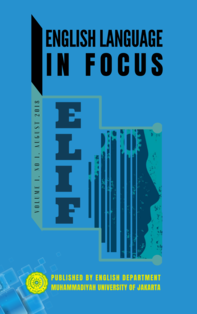Teaching English to Young Learners in Indonesia (Pros and Cons)
DOI:
https://doi.org/10.24853/elif.1.1.65-70Keywords:
language acquisition, young learners, pros and cons of teaching EYL, teaching EYL in Indonesia,Abstract
Teaching English for young learners in Indonesia still invites the controversies among the educators and psycholinguists that concern on learners’ development in thinking and communication. Because teaching English for young learners in Indonesia seems to force them in knowing the rule and forms of the sentence. In addition, some of the teachers who teach English for young learners have not the appropriate educational background that can teach the younger as well as the objective wish. Actually, there is not any regulation or decisions that obligate the school to teach English to young learners. It only depends on the school itself. In this paper, the writer would like to describe the teaching English to young learners in Indonesia in the side of its implementation and also the pros and cons based on the second language acquisition experts.References
Cameron, L. (2001). Teaching Languages to Young Learners. Cambridge, UK: Cambridge University Press.
Chodidjah, I. (2011). Lecture 4: Cognition & Language (Power Point slides). Unpublished Manuscipt, UIN Jakarta.
Ellis, R. (1994). The Study of Second Language Acquisition. Oxford, UK: Oxford University Press.
Hadisantosa, N., Huong, T. T. T., Johnstone, R., Keyuravong, S., & Lee, W. (2009). Learning through English: Policies Challenges and Prospect. Retrieved from https://www.teachingenglish.org.uk/sites/teacheng/files/publication_1_-_learning_through_english.pdf
Larsen-Freeman, D., & Long, M. (1991). An Introduction to Second Language Acquisition Research. New York: Longman Press.
Leontʹev, A. (1981). Psychology and the Language Learning Process. London: Pergamon Press.
Nababan. (1993). Kurikulum Nasional. Jakarta: Balai Pustaka Gramedia.
Rossetti, L. M. (2001). Communication Intervention : Birth to Three. Canada: Singular Thomson Learning.
Yuvaraj, A. (2009). Age Factor and Its Implication for Teaching English to Young Learners. MIJALI Published Journal, 350–359.
Downloads
Published
Issue
Section
License
Authors who publish with this journal agree to the following terms:
- Authors retain copyright and grant the journal right of first publication with the work simultaneously licensed under a Creative Commons Attribution License that allows others to share the work with an acknowledgment of the work's authorship and initial publication in this journal.
- Authors can enter into separate, additional contractual arrangements for the non-exclusive distribution of the journal's published version of the work (e.g., post it to an institutional repository or publish it in a book), with an acknowledgment of its initial publication in this journal.
- Authors are permitted and encouraged to post their work online (e.g., in institutional repositories or on their website) before and during the submission process, as it can lead to productive exchanges, as well as earlier and greater citation of published work (See The Effect of Open Access).


